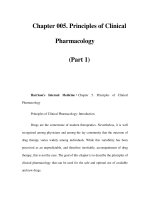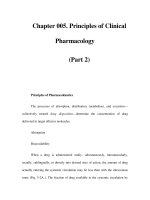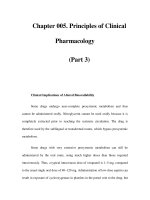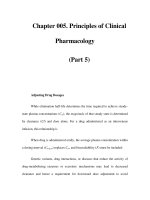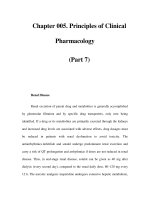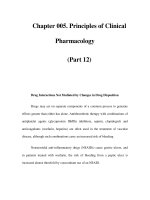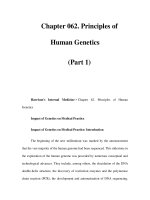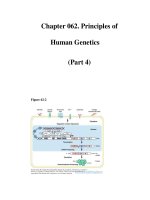Chapter 081. Principles of Cancer Treatment (Part 12) ppsx
Bạn đang xem bản rút gọn của tài liệu. Xem và tải ngay bản đầy đủ của tài liệu tại đây (38.36 KB, 5 trang )
Chapter 081. Principles of
Cancer Treatment
(Part 12)
Direct DNA-Interactive Agents
DNA replication occurs during the synthesis or S-phase of the cell cycle,
with chromosome segregation of the replicated DNA occurring in the M, or
mitosis, phase. The G1 and G2 "gap phases" precede S and M, respectively.
Historically, chemotherapeutic agents have been divided into "phase-nonspecific"
agents, which can act in any phase of the cell cycle, and "phase-specific" agents,
which require the cell to be at a particular cell cycle phase to cause greatest effect.
Once the agent has acted, cells may progress to "checkpoints" in the cell cycle
where the drug-related damage may be assessed and either repaired or allowed to
initiate apoptosis. An important function of certain tumor-suppressor genes such
as p53 may be to modulate checkpoint function.
Formation of Covalent DNA Adducts
Alkylating agents as a class are cell cycle phase-nonspecific agents. They
break down, either spontaneously or after normal organ or tumor cell metabolism,
to reactive intermediates that covalently modify bases in DNA. This leads to
cross-linkage of DNA strands or the appearance of breaks in DNA as a result of
repair efforts. "Broken" or cross-linked DNA is intrinsically unable to complete
normal replication or cell division; in addition, it is a potent activator of cell cycle
checkpoints and further activates cell-signaling pathways that can precipitate
apoptosis. As a class, alkylating agents share similar toxicities: myelosuppression,
alopecia, gonadal dysfunction, mucositis, and pulmonary fibrosis. They differ
greatly in a spectrum of normal organ toxicities. As a class they share the capacity
to cause "second" neoplasms, particularly leukemia, many years after use,
particularly when used in low doses for protracted periods.
Cyclophosphamide is inactive unless metabolized by the liver to 4-
hydroxy-cyclophosphamide, which decomposes into an alkylating species, as well
as to chloroacetaldehyde and acrolein. The latter causes chemical cystitis;
therefore, excellent hydration must be maintained while using cyclophosphamide.
If severe, the cystitis may be effectively treated by mesna (2-
mercaptoethanesulfonate). Liver disease impairs drug activation. Sporadic
interstitial pneumonitis leading to pulmonary fibrosis can accompany the use of
cyclophosphamide, and high doses used in conditioning regimens for bone
marrow transplant can cause cardiac dysfunction. Ifosfamide is a
cyclophosphamide analogue also activated in the liver, but more slowly, and it
requires coadministration of mesna to prevent bladder injury. Central nervous
system (CNS) effects, including somnolence, confusion, and psychosis, can follow
ifosfamide use; the incidence appears related to low body surface area or the
presence of nephrectomy.
Several alkylating agents are less commonly used. Nitrogen mustard
(mechlorethamine) is the prototypic agent of this class, decomposing rapidly in
aqueous solution to potentially yield a bifunctional carbonium ion. It must be
administered shortly after preparation into a rapidly flowing intravenous line. It is
a powerful vesicant, and infiltration may be symptomatically ameliorated by
infiltration of the affected site with 1/6 M thiosulfate. Even without infiltration,
aseptic thrombophlebitis is frequent. It can be used topically as a dilute solution in
cutaneous lymphomas, with a notable incidence of hypersensitivity reactions. It
causes moderate nausea after intravenous administration.
Chlorambucil causes predictable myelosuppression, azoospermia, nausea,
and pulmonary side effects. Busulfan can cause profound myelosuppression,
alopecia, and pulmonary toxicity but is relatively "lymphocyte sparing." Its routine
use in treatment of CML has been curtailed in favor of imatinib (Gleevec)or
dasatinib, but it is still employed in transplant preparation regimens. Melphalan
shows variable oral bioavailability and undergoes extensive binding to albumin
and α
1
-acidic glycoprotein. Mucositis appears more prominently; however, it has
prominent activity in multiple myeloma.
Nitrosoureas break down to carbamoylating species that not only cause a
distinct pattern of DNA base pair–directed toxicity but also can covalently modify
proteins. They share the feature of causing relatively delayed bone marrow
toxicity, which can be cumulative and long-lasting. Streptozotocin is unique in
that its glucose-like structure conveys specific toxicity to the islet cells of the
pancreas (for whose derivative tumor types it is prominently indicated) as well as
causing renal toxicity in the form of Fanconi syndrome, including amino aciduria,
glycosuria, and renal tubular acidosis. Methyl CCNU (lomustine) causes direct
glomerular as well as tubular damage, cumulatively related to dose and time of
exposure.
Procarbazine is metabolized in the liver and possibly in tumor cells to yield
a variety of free radical and alkylating species. In addition to myelosuppression, it
causes hypnotic and other CNS effects, including vivid nightmares. It can cause a
disulfiram-like syndrome on ingestion of ethanol. Altretamine (formerly
hexamethylmelamine) and thiotepa can chemically give rise to alkylating species,
although the nature of the DNA damage has not been well characterized in either
case. Thiotepa can be used for intrathecal treatment of neoplastic meningitis.
Dacarbazine (DTIC) is activated in the liver to yield the highly reactive methyl
diazonium cation. It causes only modest myelosuppression 21–25 days after a dose
but causes prominent nausea on day 1. Temozolomide is structurally related to
dacarbazine but was designed to be activated by nonenzymatic hydrolysis in
tumors and is bioavailable orally.
